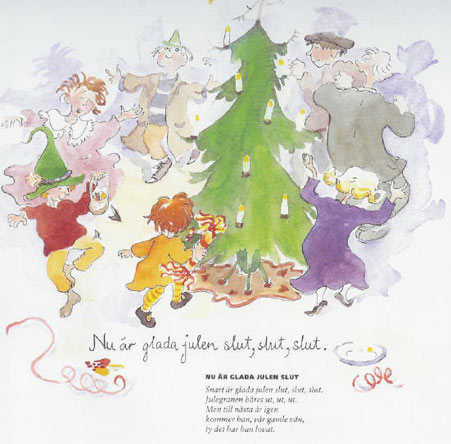Twelfth Night 2007
TRETTONHELG OCH TJUGONDAG KNUT
Twelfth Night and Knut
Twelfth Night or Epiphany, the 6th-7th of January, is celebrated in many homes as an extension of the Christmas festivities, in terms of food at any rate. Children are still on holiday from school, and many parents take a holiday up until this day, too. In olden days it was customary to put on a Twelfth Night pageant, telling the Christmas story, or for groups of white-clad boys (as described under “Lucia”) to go the rounds of the village. These traditions live on in only a very few communities today.
One week after Twelfth Night the Swedish calendar celebrates the name Knut. Prior to a seventeenth century calendar reform Knut was celebrated on Twelfth Night and marked the end of the holiday season. As a result of the reform Knut was moved forward one week, and since Swedes were accustomed to ending their Christmas holidays on Knut’s day, they simply continued celebrating an extra week.
This is the day people finally part with their Christmas trees — if they haven’t already done so. All the decorations are first removed, and the act is often the occasion for a final party — this one especially for the children. Friends and classmates are invited over to eat cakes and candies, play games and “plunder” the tree. All the small trinkets are carefully removed and stored away, while edible ornaments — ginger biscuits, caramels, and the like — are gobbled up.
Finally, the group pick up the tree and literally toss it out of the house or flat, singing a song that, in translation, goes something like this:
Christmas has come to an end,
And the tree must go.
But next year once again
We shall see our dear old friend,
For he has promised us so.
In the past Knut was also an occasion for masquerading. Men and boys dressed up as “Old Knut” would prowl about, playing practical jokes and doing mischief. In some parts of the country — particularly where immigrant Walloons settled in the seventeenth century — Knut is the occasion for regular carnivals, especially in the province of Uppland just north of Stockholm.
Author: Ingemar Liman
Translation: Charly Hultén
Special Event

Join us for Twelfth Night, Dionysian Style Celebrations in the Woods.




The trees are whispering word of this to every traveller and resident at Riversleigh!
I love this – having a ritual to depart with Christmas makes it not so sad to put everything away.
Patricia
Fabulous addition, Heather 😉
Interesting. As an secular American, I never knew about the 12th Night custom! I knew about Shakespeare’s play The 12th Night but I read it way back in high school and I only remember some of the characters/the basic plot. However, for years I have been reluctant to remove the Christmas decorations exactly on New Years day. My preference was to wait until the first full weekend of Jan before doing so. Maybe there was some unconscious knowing that I was not aware of!
What a brilliant way to lift the spirits on a cold and damp eve in early January!
Enjoying reading these thoughts. Maybe Cheshire, these things never leave us?
There is a slight cast to the eyes of the figure in your drawing, Heather – I think this means she is plotting something ….. beware of someone who won’t look you straight in the face!